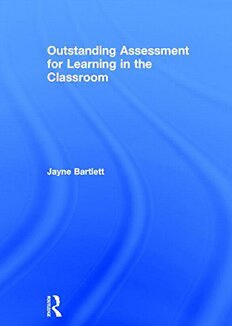Table Of ContentOutstanding Assessment for Learning
in the Classroom
The main feature of an outstanding lesson is that all students make progress.
Taking the structure of a lesson as the starting point, this book demonstrates
how assessment for learning can be used to enhance and support all aspects
of the learning process. Including chapters on embedding assessment during
each phase of the lesson, using assessment data to inform planning, ques-
tioning techniques and feedback, the book will help you to use assessment
effectively to produce outstanding results.
Packed full of practical strategies, this book shows you how you can make
assessment meaningful in the classroom, directly impacting on your students
and creating a more autonomous learning environment. It is written specifi-
cally with the class teacher in mind and draws on a range of different exam-
ples across many subjects to deliver ideas that can be translated with ease to
everyday teaching practices.
With a strong focus on including assessment practices in the planning
process to achieve outstanding results, this book covers:
• assessment for learning and an overview of the learning cycle;
• practical teaching strategies and effective techniques to use in the classroom;
• marking, feedback and using data to drive learning; and
• embedding assessment for learning in your classroom, department and
school.
An effective guide for outstanding teaching and learning, this book offers an
innovative approach and is packed full of practical exercises that are easy
to apply in the classroom, proving essential reading for newly qualified and
experienced teachers alike.
Dr Jayne Bartlett has worked in education for over ten years in a range of
schools with roles at senior leadership level and is currently working freelance
as an independent teaching and learning trainer and consultant.
This page intentionally left blank
Outstanding
Assessment for
Learning in
the Classroom
Jayne Bartlett
First published 2015
by Routledge
2 Park Square, Milton Park, Abingdon, Oxon OX14 4RN
and by Routledge
711 Third Avenue, New York, NY 10017
Routledge is an imprint of the Taylor & Francis Group, an informa business
© 2015 Jayne Bartlett
The right of Jayne Bartlett to be identified as author of this work has been asserted
by her in accordance with sections 77 and 78 of the Copyright, Designs and
Patents Act 1988.
All rights reserved. No part of this book may be reprinted or reproduced or
utilised in any form or by any electronic, mechanical, or other means, now
known or hereafter invented, including photocopying and recording, or in any
information storage or retrieval system, without permission in writing from
the publishers.
Trademark notice: Product or corporate names may be trademarks or
registered trademarks, and are used only for identification and explanation
without intent to infringe.
British Library Cataloguing in Publication Data
A catalogue record for this book is available from the British Library
Library of Congress Cataloging-in-Publication Data
Bartlett, Jayne.
Outstanding assessment for learning in the classroom / Jayne Bartlett. – Second edition.
pages cm
Includes bibliographical references and index.
1. Educational tests and measurements. 2. Teaching. 3. Academic achievement. I. Title.
LB3051.B268 2015
371.26–dc23
2014038779
ISBN: 978-1-138-82449-2 (hbk)
ISBN: 978-1-138-82450-8 (pbk)
ISBN: 978-1-315-71723-4 (ebk)
Typeset in Melior
by Cenveo Publisher Services
To Oliver and Olivia
This page intentionally left blank
Contents
List of figures and tables x
Acknowledgements xii
Introduction xiii
1 What do we mean by assessment for learning? 1
Learning to learn and the learning environment 4
2 Sequencing and planning for learning 8
The learning cycle 9
3 Assessment for learning: the start of the lesson 18
Bell work 19
Learning outcomes 27
The Big Question 31
The first learning cycle: the starter activity 35
Benchmarking learning 36
Review 55
Start of the lesson: summary 56
vii
Contents
4 Using assessment to drive learning in the main body of the lesson 58
Sequencing the learning 60
Mini-assessments 66
The main assessment activity 70
Assessment opportunities when pupils work together 87
Assessment opportunities in independent learning 91
Individual learning preferences: supporting the
assessment process 91
Linking with other departments: creating a meaningful
assessment opportunity 95
5 The final challenge: the final assessment 98
The Big Question 98
Plenary activities 101
Reflection 108
Reverse bell work 109
Home learning 110
6 Assessment through questioning 112
Wait time and hands down 113
Misconceptions 116
Open and closed questions in assessment for learning 116
Bloom’s taxonomy 118
‘Think, pair, share’ 122
Probing questions to develop a concept 123
Teacher input 125
viii
Contents
7 Marking and feedback 128
Assessment criteria 128
Learning outcomes and success criteria 131
Verbal feedback 132
Target setting 134
The quality of assessments 137
Marking and feedback 138
Self-assessment and peer-assessment 149
Reflection 153
Mini-assessment points 154
The final assessment activity 155
The learning environment 155
8 Using data to drive learning 159
Statistical models 160
Targets 161
School tracking systems 163
Evaluation processes 164
9 Embedding assessment for learning 168
Introducing new techniques 169
Quality assurance 171
Marking audit 173
Lesson study 174
Conclusion 176
Bibliography 180
Index 183
ix

